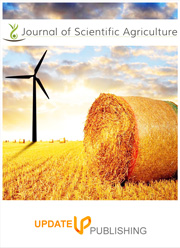Evaluation on dry forage yields and nutritional characteristics of introduced herbaceous legumes in Myanmar
DOI:
https://doi.org/10.25081/jsa.2021.v5.6647Keywords:
Forage yield, Gas production, Herbaceous legume, Nutritive valuesAbstract
The study was carried out to evaluate the forage yields, nutritive values and in vitro fermentation parameters of herbaceous legumes. Five varieties of introduced herbaceous legumes; Stylosanthes guianensis cv. Ubon stylo, Macrotyloma axillare cv. Archer, Centrosema brasilianum cv. Ooloo, Stylosanthes guianensis cv. Stylo 184 and Macroptilum bracteatum cv. Cadarga were evaluated at the research farm, University of Veterinary Science, Yezin, Myanmar. No fertilizer and no irrigation were applied for cultivation to test drought resistance. Dry forage yield, nutritive values and gas production at four harvesting times were measured with 4×5 factorial arrangement (5 legumes and 4 harvesting time) in randomized complete block design. There was no interaction between legumes and harvesting time on forage yield, nutritive values and fermentation parameters but they were affected by the main effects of legume types and harvesting time. Among the legume forages, the highest dry forage yields were found in Ooloo, Ubon stylo, and Stylo 184, and followed by the DM yield of Archer and Cadarga. The DM yield of the second harvest was significantly higher (p<0.05) than those of the first, third and fourth harvest which were not significantly different from each other. As a chemical composition, the DM content of Archer was lower (p<0.05) than those of other varieties. Among the legumes forages, the lower CP content was found in Cadarga. The higher NDF was observed in Ooloo. Ooloo, Ubon stylo and Cadarga showed higher ADF in comparison with the other two varieties. Among the harvesting time, the lowest DM content was found at the first harvest. The highest CP content was found at third harvest. The NDF content was not significantly different. The lowest ADF content was found in fourth harvest. According to the dry forage yield, Ubon stylo and Ooloo had the highest dry forage yield and in term of nutritive values, Stylo 184 and Archer had higher nutritive values. As the main effect of forages, Stylo 184 and Archer had higher gas production in comparison with the other varieties. As the main effect of harvesting time, the fourth harvest had the highest gas production in comparison with other harvesting time. It could be better for cultivation by application of fertilizer and irrigation to get more forage yield and quality.



 .
.